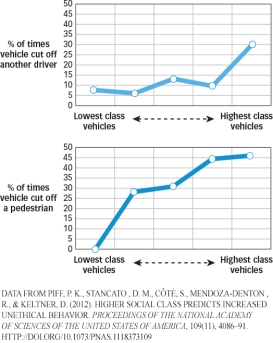Use the following to answer questions :
Scenario I
Scenario I is based on and presents data from the following study (reproduced from p.26 of the textbook) :
Piff,P.K. ,Stancato,D.M. ,Côté,S. ,Mendoza-Denton,R. ,& Keltner,D.(2012) .Higher social class predicts increased unethical behaviour.PNAS Proceedings of the National Academy of Sciences of the United States of America,109(11) ,4086-4091.doi:10.1073/pnas.1118373109
Piff and colleagues (2012) used naturalistic observation techniques to determine if wealthy people behaved more or less ethically than people who were not wealthy.In one study,observers stood at a busy intersection and recorded the make,model,and year of each approaching car.They also noted if the car cut off other cars or pedestrians at this intersection.
Major findings of Piff et al.(2012) are presented in Figure 1.1.This figure shows the percentage of times vehicles cut off another driver (top panel) or pedestrians (lower panel) as a function of the social status of the vehicles (with more expensive cars ranked higher in social status) .
Figure 1.1 
-(Scenario I) A psychologist believes that people in higher and lower social classes learn norms that then affect their behaviour in many different settings.One such norm is that people in higher social classes tend to view themselves as more important than others.As such,the psychologist is not surprised that people driving expensive cars are more likely to disregard the rights of others.This _____ psychologist would predict that _____.
Definitions:
Trade Barriers
Measures implemented by governments to control or limit the volume of goods and services imported or exported, affecting international trade.
Trade Surplus
A situation where the value of a country’s exports exceeds the value of its imports.
Balance of Trade
The difference in value between a country's imports and exports over a given period, indicating the net earnings on foreign trade.
Foreign Trade Sector
The segment of an economy's market dealing with the exchange of goods and services across international borders.
Q4: If I present you with the word
Q6: An advantage of the evolutionary over the
Q35: Julie believes that the society in which
Q135: The basic units of semantic memory that
Q155: The three major modes of thought are
Q178: The main reason why intelligent people earn
Q210: Which research question is MOST consistent with
Q280: When you are attempting to solve an
Q343: A trance-like state characterized by suggestibility is
Q344: Psychoanalysis became quite controversial in North American